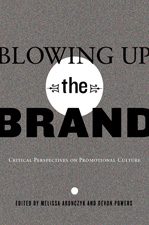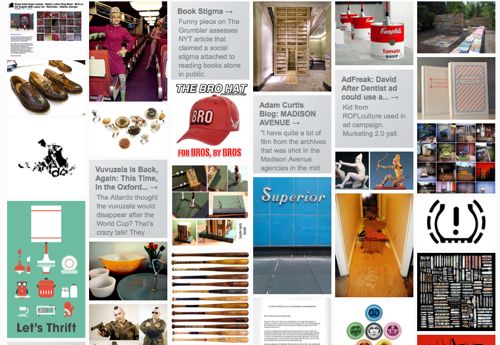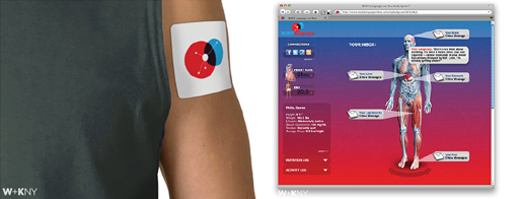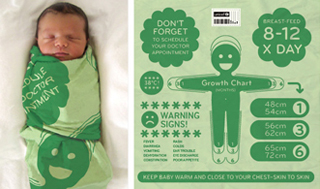No Consumed in today’s Times Mag, but here’s something if you’re bored:
On May 8, 2009, I gave a talk at a conference called “Blowing Up The Brand,” at NYU. Recently, pretty much all of the talks at that event were collected into a book — except mine. This made me curious to revisit my remarks. Were they really that bad? I went through the text and cleaned it up a bit, and added some “footnotes” to more recent observations by others that are related to the matters I spoke about, and decided to post it here. I guess it’s long for a site like this, but if you have time to read it, I welcome feedback — comments open.
It’s true that in some ways these remarks are somewhat dated — but in other ways I think they hold up pretty well. But whatever. The point is having looked at this again I’m thinking of revising and updating it in connection with something else I’m working on.
Here’s a summary if you want to skip ahead to anything that sounds interesting:
- Section 1 deals with branding and individuality, and my basic contention that the “grammar of branding” is universally understood (in America). This is something I’ve explored before, as many of you know, so you can skip that part if you’re tired of it.
- Section 2 introduces my sense (as of May 2009, anyway) of the “transactional” nature of much social media. I think this core point of the talk is still very important, and under-discussed. So you might start there.
- Section 3 names three related characteristics of much online expression: The “audience motive”; the escalation of easiness; and the privileging of measurability. Again, I think this holds up, and is more relevant than ever.
- Section 4 attempts to tie together all of the above to offer a cautionary conclusion on the subject of creativity vs. “thinking of yourself as a brand” in the present social-media era. This section could have been better, but I believe the main message holds true and is worth consideration today.
I’ve been adding links and footnotes to the below, some of which post-date the actual talk but that I think are relevant to what I said in some way. I will continue to do so as things occur to me, or you suggest them.
————————
“If You Follow Me, I Will Follow You Back”
[May 8, 2009, talk at NYU “Blowing Up The Brand” conference]
In 2008, during a Q&A session at the end of an event intended to promote a book I had recently published, somebody asked me for what amounted to career advice. Evidently my answer included a remark about thinking of oneself as a brand. I honestly don’t remember the details of what I said, but in the months that followed several people who had been at that event mentioned it to me. Clearly they had walked away that night with general idea that I had told them to think of themselves as brands. And more to the point: They thought that was pretty good advice.
A year later here I am at “Blowing Up The Brand,” a two-day event that aims to explore critical perspectives on “promotional culture,” described as “the extension of promotional discourses, practices and performances into virtually all areas of public life.”
Thinking of yourself “as a brand” sure sounds of a piece with that critique. In other words, I may be part of the problem that I have been asked to come here to examine. This is a surprising thing for me to confront, particularly given that the book I was promoting when I was asked that question here in New York a year ago offered a not-very-upbeat critique of the blurring of marketing and day-to-day public life.
Frankly, I’m not proud of this turn of events. On the one hand I think that as a raw, practical piece of advice, I would stand by what I said to that audience in 2008. On the other hand, with the benefit of hindsight, there’s a big asterisk I would put next to that observation now. My remarks here are that asterisk. I want, now, to put my throwaway comment into what I hope is a more considered context. Please continue…
 Melissa Aronczyk writes:
Melissa Aronczyk writes:
Please join us to celebrate the launch of a new edited collection:
Blowing Up the Brand: Critical Perspectives on Promotional Culture (Popular Culture and Everyday Life) , eds Melissa Aronczyk and Devon Powers
, eds Melissa Aronczyk and Devon Powers
With contributions from Celia Lury and Liz Moor, John Corner, Jefferson Pooley, Arlene Davila, Miriam Greenberg, Hongmei Li, Graham Knight, Waddick Doyle and Gabriele Cosentino, Alison Hearn, Mary Ebeling, Sarah Banet-Weiser and Marita Sturken, Devon Powers, Melissa Aronczyk, and Jonathan Gray.
WHEN: Tuesday 21 September, 5:30 pm – 7:30 pm
WHERE: NYU Institute for Public Knowledge (5th floor, 20 Cooper Square, New York, NY)
RSVP: http://www.nyu.edu/ipk/events/129
This book draws from a conference that I spoke at and mentioned here last year (and where I had the pleasure to meet several Murketing.com readers).
However, my song and dance is not included in this book. :(
(Also: I won’t be able to come to this event, but I would if I lived in NYC. The book looks great. Big congrats to Melissa and Devon!)
looks great. Big congrats to Melissa and Devon!)
Posted Under:
To Do by Rob Walker on September 13, 2010
Comments Off on Blowing Up The Brand: The book

Terry Jones, the Florida pastor who threatened to burn Korans, rocking a Harley Davidson T-shirt at LaGuardia this weekend.
It’s an iconic American (ativan) brand, y’all.
 HEARING THINGS
HEARING THINGS
Can the value of music reside in a lamp (or stickers, or a high-end sculpture)?
Merchandise is gaining momentum, and it’s not hard to imagine a time when a fan buys a sculpture, home décor item or other tangible good and gets the music as a kind of free soundtrack accompaniment.
Read the column in the September 12, 2010, New York Times Magazine, or here.
Discuss, make fun of, or praise this column to the skies at the Consumed Facebook page.
Posted Under:
Consumed by Rob Walker on September 12, 2010
Comments Off on In The New York Times Magazine: Music Objects 2.0
 SAY ANYTHING, THING
SAY ANYTHING, THING
If our favorite objects could talk, what tales would they tell?
The relationship between the possessions we value and the narratives behind them is unmistakable. Current technologies of connection, and enterprises that take advantage of them, surface this idea in new ways — but they also suggest the many different kinds of stories, information and data that objects can, or will, tell us.
Read the column in the September 5, 2010, New York Times Magazine, or here.
Note: Earlier looks at a different sort of thing-story — the manufacturing “narrative” of an object — aret here and here,
Discuss, make fun of, or praise this column to the skies at the Consumed Facebook page.
Posted Under:
Consumed,
Things/Thinking by Rob Walker on September 5, 2010
Comments Off on In The New York Times Magazine: Things that tell stories
 Titans of Finance, my collaboration with artist Josh Neufeld, first published as a comic book back in 2001 (and evidently now very rare in the original analog version) is now available for the iPad!
Titans of Finance, my collaboration with artist Josh Neufeld, first published as a comic book back in 2001 (and evidently now very rare in the original analog version) is now available for the iPad!
At least that’s what I’ve been told. I don’t have an iPad, and I’m not even certain what I should link to.
But if you have an iPad, and would like to spend for $4 to enjoy this collection of factual comix tales of money and greed, then visit the, uh, iPad bookstore? Or whatever? And look for Titans of Finance. And then buy it. Or even if you don’t buy it, let me know that you found it, and maybe if you have a suggestion as to what sort of link I should provide.
This unlikely turn of events is thanks to the efforts of Garrett County Press.
Thanks!
(Related: Can the iPad save Spider Man?)
 CROSSOVER POP
CROSSOVER POP
One of the longest-running — and weirdest — unsolicited celebrity endorsements
Insane Clown Posse mention Faygo a lot and spray concertgoers with it during shows. This has resulted in one of the longest-running instances of an unsolicited celebrity endorsement.
Read the column in the August 29, 2010, New York Times Magazine, or here.
Discuss, make fun of, or praise this column to the skies at the Consumed Facebook page.
Posted Under:
Consumed,
Entertainment by Rob Walker on August 28, 2010
Comments Off on In The New York Times Magazine: Involuntary branding

Click it.
Recent feedback suggests I have not made this clear, so let me try again:
I’m not updating this site so much lately (though still sometimes, weekly at a minium) but I do post regularly, and quite a lot, at (among other places):
http://murketing.tumblr.com
The riot of delightful “content” there is suggested by the image above.
AND
http://unconsumption.tumblr.com
The latter also features posts by my fascinator-collaborators. Great stuff. Again, I’ve provided a visual sampler, below. Check it out.

Click it.
Posted Under:
rw by Rob Walker on August 25, 2010
Comments Off on Further amusement
 BANANA DEMOCRACY
BANANA DEMOCRACY
A design campaign that has made the most of minimal packaging.
Humans have always noticed novelty, but it’s harder to get our attention in the multicolored and abundant context of a megamart, where one heap of bananas looks much like another. This makes it all the more impressive that Chiquita has received so much notice by being creative with the little blue stickers that adorn its flagship fruit
Read the column in the August 22, 2010, New York Times Magazine, or here.
Discuss, make fun of, or praise this column to the skies at the Consumed Facebook page.
Posted Under:
Consumed,
The Designed Life by Rob Walker on August 22, 2010
Comments Off on In The New York Times Magazine: Fruit branding
Q: I just wanted to recommend “Buying In” to someone, and I could not remember the full name, so I went to Amazon, and was surprised to find two full names, one with “The Secret Dialogue” and the other with “What We Buy”. Are these the same book or two different books? I want to make sure that I’m recommending the one I read.
A: Buying In: What We Buy prednisone and Who We Are is in fact the same book as Buying In: The Secret Dialogue Between What We Buy and Who We Are
is in fact the same book as Buying In: The Secret Dialogue Between What We Buy and Who We Are . The publisher thought it would be good to shorten the subtitle when the paperback version was published, because it would “allow for a less-cluttered and more powerful cover design.” Personally I thought the “secret dialogue” bit was the most interesting element of the title, but what do I know? Well, I know what I said when this was suggested: “okay.” It’s actually not all that unusual for books that are, shall we say, not best-sellers, to have their subtitles or even titles tweaked — Tyler Cowen’s last book came out in paper with a completely different title than the hardback version, to name a recent example. In any event, it is the same book; the only difference is that a few typos are corrected in the paperback version. If you recommend either, you should be fine.
. The publisher thought it would be good to shorten the subtitle when the paperback version was published, because it would “allow for a less-cluttered and more powerful cover design.” Personally I thought the “secret dialogue” bit was the most interesting element of the title, but what do I know? Well, I know what I said when this was suggested: “okay.” It’s actually not all that unusual for books that are, shall we say, not best-sellers, to have their subtitles or even titles tweaked — Tyler Cowen’s last book came out in paper with a completely different title than the hardback version, to name a recent example. In any event, it is the same book; the only difference is that a few typos are corrected in the paperback version. If you recommend either, you should be fine.
N.B.: Questions in “Ask Murketing,” basically a new feature, though I may have tried it earlier, are real and verbatim, and selected for inclusion from email I receive because I believe the answer may be relevant, or of interest, to (tramadol) others.
During a recent viewing of 2001, I got a bit fixated on HAL‘s “eye,” as a kind of icon of creepy machine intelligence that seems like it might be a useful visual reference point for someone to exploit around about now, when speculation, euphoria, and paranoia about computers, privacy, and digital intelligence are frequent topics of discussion:

And yesterday E (aware of my interest in the above) pointed out to me this promo image of the next Droid phone.

What do you think? Is that an intentional HAL reference?
I started Consumed in 2004, and I think I’ve had five or six corrections — about one a year. Last weekend’s column contained a different sort of mistake — it’s factually correct, so there will be no correction, but I wish I could go back in time and fix it. I quoted from an online tutorial about making wallpaper from book pages: “You don’t necessary need old antique books, just books with pages with a yellow tint.” When I quoted that bit, I just cut the line and pasted it, and put it in quotes. I was reading it as “You don’t necessarily need old antique books, just books with pages with a yellow tint.”
You see the difference, right? I read “necessarily,” but it says “necessary.” Which is ungrammatical, obviously. It was a typo by whoever wrote the tutorial. But I missed that. And I wasn’t the only one, because even in the last page proof I saw, I was still reading it that way, and nobody had changed it — so we were all reading it, I think, as “necessarily.” But between the last proof and the column going to press, somebody caught the mistake, so it ran like this: “You don’t necessary [sic] need old antique books, just books with pages with a yellow tint.”
It happens that I have strong feelings about the use of [sic]. Hackish writers deploy this routinely to make whoever they are quoting look stupid. It’s a very cheap move, and a sure sign, in my view, of third-tier writing. It’s acceptable to use [sic] if there’s no way around it, and it’s sometimes excusable to use it if you’re trying to underscore the sloppiness, or stupidity, or whatever, of some powerful figure — if the president of an Ivy League school made a glaring mistake in some official context, maybe that would get a pass. But in general, [sic] is a cheap move — we all make mistakes, typos, little glitches, that mean nothing. This web site is full of such errors — for all I know this post will contain such errors, because I’m writing it quickly, and I don’t have a proofreader, etc. In other words, I’m no different than the person I quoted making some workaday, meaningless error.
If only I’d noticed it myself! I would have simply paraphrased: “You don’t necessary [sic] need old antique books, just books with pages with a yellow tint,” as “One doesn’t necessarily ‘need old antique books,’ the tutorial reassured, ‘just books with pages with a yellow tint.'” This would have achieved exactly what I wanted to achieve, without a distracting [sic] that appears to poke at some random person’s random typo. But because I failed to pay close enough attention, the latter scenario is exactly what came to pass.
I regret the error.

Omni Consumer Products Corporation, leading the way in making imaginary brands into actual buyable products (and written about Consumed a while back) has sent me an advance sample of its next big offering: Stay Puft Quality Marshmallows. They are caffeinated.
Yikes.
Look out for them…
Posted Under:
Imaginary Brands by Rob Walker on August 13, 2010
Comments Off on Next up from Omni Consumer Products
 SHELF EXPRESSION
SHELF EXPRESSION
Physical books’ bright future — as decorative objects and props.
Set aside any emotional attachment you may feel toward the reading of physical books; the truth is that creative uses for books that do not involve engaging with words on a page already abound.
Read the column in the August 8, 2010, New York Times Magazine, or here.
Discuss, make fun of, or praise this column to the skies at the Consumed Facebook page.
Yes, this column is the culmination of my long-running musings on this subject, here and here.
Posted Under:
Consumed by Rob Walker on August 8, 2010
Comments Off on In The New York Times Magazine: Books, the idea

You may have seen this elsewhere online, since it’s been making the rounds, but PSFK (friends of Murketing, I should mention) recently put out a rather massive report full of ideas relating to the future of health care. It takes me days to get through documents like this — more than 200 pages of ideas and concepts, from PSFK itself as well as a battery of agencies they asked to contribute. But I’m always happy to see the various smart people in the trend/marketing/design worlds putting the minds to a problem bigger than, you know, how to sell more stuff. And I have a particular interest in health care being improved by technology and design and so on, both here in the U.S., and in the world’s underdeveloped regions where the problems remain shockingly acute.
One of the dominant problems in both scenarios, I think it’s safe to say, is communication with professionals, so I was pleased to see that listed near the top of the “Challenges” list: “Limited ability to contact physicians and health workers when necessary.” Lots of proposed improvements on that front involve the marriage of mobile technology with the Internet.
The report names ten challenges in all, and the concepts range from self-monitoring ideas to practical design suggestions. Check out the whole thing here. PSFK has also been doling out highlights on its site.

Body Language - Weiden + Kennedy NY

Information Blanket - BMB

CHW Radio Network - Story Worldwide

UNICEF SMS - Great Works
Posted Under:
Uncategorized by Rob Walker on August 6, 2010
Comments Off on PSFK’s Future of Health Report




 "
"


 HEARING THINGS
HEARING THINGS





















 Kim Fellner's book
Kim Fellner's book  A
A